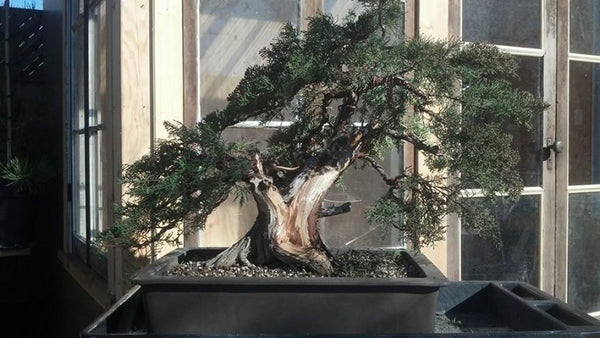Blog # 13 Conifers going through winter and thoughts on wiring
Our goal is to always have fun while doing bonsai, hence our company slogan You know you are a bonsai freak when you ...
When is the best time to wire conifers and why? An easy answer is winter, but why winter. As the temperature begins to drop, all trees begin to protect themselves against the coming winter extremes by going dormant. Yes even conifers go slightly dormant here in California. Why do they do this? They go dormant to protect themselves from whatever winter throws at them. How do they do this? As the tree goes slightly dormant the sap and cambium reproduction flow decreases. Why does the sap flow decrease. Because the sap flow is not needed as much during winter months, it does however still move a little sort of like antifreeze. Because of this slowed growth and decrease in cell reproduction the cambium and hardwood become one. If you really want to get deep go Google xylem and phloem. Please stop by my Facebook group https://www.facebook.com/groups/bonsaifreak/
A little blurry, but this is right after picking up the tree...just thinning it.

This is a juniper i picked up in July, i emergency re-potted and thinned it
Ahaaa you say. I get it. The best time to wire conifer is when the cambium and hardwood become one...exactly. Since the tree is protecting itself at this time of year, you apply wire and bending the trunk or branches is sort of what nature would be doing. The wind blows and adds extreme curves, twist and snaps off branches. The snow sits on the branches for months and this causes a natural downward curve causing the branches to have downward growth. The freeze then comes and causes some die back....this is nature. Back to your personal conifer, one would not be advised to do extreme bending during May through October. Why, because if you over bend and twist the branches on a conifer during this time the cambium and hardwood are not bound together and could separate very easily causing the branch to die. On the other hand May through October is a great time to make your Jins and Shari's since the bark is so easily peeled off.

At the half way point of initial wiring
Is wiring done different on different conifers? Yes...I should clarify but what do I mean...different. When wiring most pine branches, the branches are given gentle curves and wired out and slightly down most of the time, there are exceptions. The buds should be facing out when you are done. The cool thing about a pine unlike any other tree is that the buds will grow straight up making a perfect pad if done right. Is there a difference between wiring a young tree as opposed to an old tree? Yes a young tree of almost each specifies grows a lot faster than an older tree. Case in point. I gently wired three young black pines and within 3-4 months the wire was cutting in and had to be removed. I wired an older pine and the wire was able to stay on the tree for over a year before it began to cut in. OK, be honest the top strongest part could have had the wire removed a little earlier. This is also a great time to really twist up and wire the hell out of your smaller and more malleable pines by adding movement to the trucks of smaller black pines. Unlike a deciduous tree, wiring cutting in a little bit is exceptible on conifers because it gives it a little character.

Initial wiring done, this tree will be fun to carve and work on in the coming years, I plan on giving it a break
and then wiring secondary branches in November or December of this year. Enough work for a while
A juniper on the other hand can have major drastic sharp bends and curves and you know what; it should. Why? Because when mimicking nature the junipers usually grow in extreme conditions such as in the high mountains or low desert where the wind, snow and high heat can be seasonally extreme, somehow the junipers must adapt to these conditions. This is why you see a lot more dramatic sharp curves, deadwood, shari's and jins done by nature on junipers collected from the wild. As opposed to a pine that may still have extremes, but not as extreme since it usually grows near the coast. Some junipers could be completely covered in snow for two or three months, or in lower elevations, not get any water for 6-9 months. These harsh conditions really mold these beautiful works of art. OK so back to us and wiring. Do you have a tree that you have been thinking about for a while that needs wiring. As my friend Larry would say...go get it sit in front of your Television while you’re watching your favorite TV show and add some sweet curves to your otherwise straight branches....oh yeah....use cooper it will hold a lot better.
